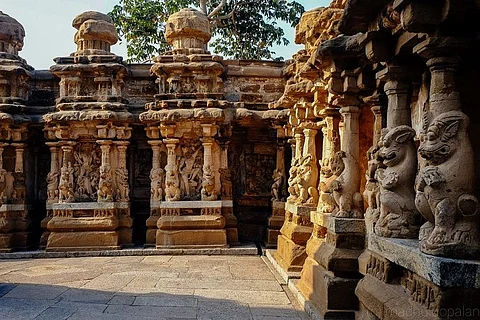

The Pallavas were a powerful ancient dynasty that ruled a huge part of Southern India, including present day Tamil Nadu, between the 6th and 9th centuries AD. Kanchipuram, one of the holiest cities for Hindus, was their capital. The Pallava rulers were passionate about art and architecture, and their reign saw extensive experimentation and evolution in temple building.
The earliest Pallava temples were rock-cut cave shrines. These soon gave way to monolithic temples carved out of giant boulders, resembling chariots or ‘rathas’. It was during the rule of Narasimhavarman II or Rajasimha, that the tradition of building structural temples began. Structural temples are like those we see all over the region today - built stone by stone, and not excavated out of a rock. In the beginning, structural temples were built almost entirely in sandstone. The most stunning example of this is undoubtedly the Kailasanathar Temple of Kanchipuram. It is one of the earliest structural temples and the largest one built by the Pallavas.
The Kailasanathar Temple is dedicated to Lord Shiva. Inscriptions here in the Grantha script, list the various titles of its builder Narasimhavarman II. Additions were made to the structure by his son Mahendravarman III, but no significant changes were made by later rulers from the Chola or Vijayanagara empires, so it remains an exclusively Pallava monument.
The foundation of the temple is made of granite, in order to bear the weight of all the sandstone above. The entrance wall is lined with eight small shrines - two to the left of the doorway, and the rest to its right. Right after you step in is a small shrine with a gopuram above it. This was an addition by Mahendravarman. Its walls are adorned with sculptures of several forms of Shiva like Bhikshatana (in which he is a mendicant begging for alms) and Somaskanda (depicted along with his consort Uma and child Kartikeya).
The main shrine is built with a pyramidal vimana, which went on to become typical of Dravidian architecture. Inside, the main deity is a majestic Shivalinga in black granite. The walls around this shrine are covered with exquisite reliefs depicting Shiva in forms like Lingodbhava (Shiva emerging out of a Shivalinga), Urdhava Tandavamurti (performing his cosmic dance), Tripurantaka (the destroyer of three cities ruled by asuras), Harihara (part Vishnu and part Shiva), etc. Lion pillars were a Pallava speciality, and in this temple, they seem to have chosen to go with an absolute profusion of erect lions facing almost all directions.
Fifty-eight small shrines line the inner side of the compound wall surrounding the main shrine. This is the most striking and unusual feature of this temple. The shrines are filled to the brim with stunning sculptures, again depicting Shiva in various dance poses, with his family, etc. It would be no exaggeration to say that this temple is one of the biggest repositories of Shaivite iconography. Some of the niches between the mini-shrines show patches of beautiful murals that have survived the ravages of time.
Outside, a stone Nandi (or bull) sits on a pedestal facing the temple complex, surrounded by four lion pillars, which once held up a mandapa.
Early mornings at the Kailasanathar Temple are incredibly serene - it’s just you and the cool blocks of stone that have quietly watched history unfolding for centuries, in a silence that is only interrupted by the chirping of parrots. Kanchipuram, one of India’s oldest continuously inhabited cities is often called the land of a thousand temples, and this beautiful temple is the crowning glory of the magnificent city.
All photographs by Madhumita Gopalan
Madhumita Gopalan is a photographer, blogger and history enthusiast who loves photo-documenting travel, culture and architecture. She blogs at www.madhugopalan.com
Also read: